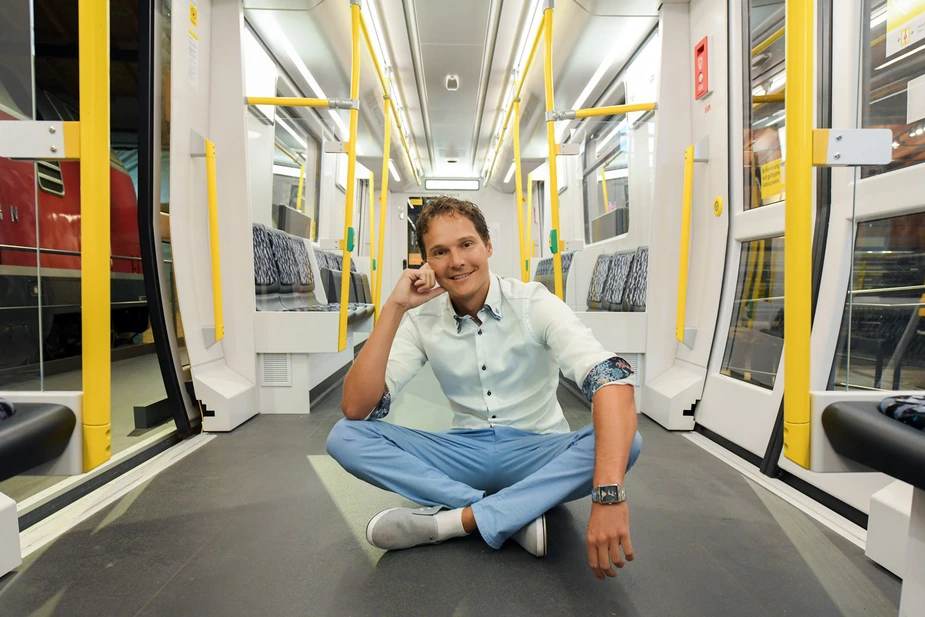Designing trams and subways
What will the next generation look like?
Whenever new tram or U-Bahn vehicles roll on the tracks, it is likely that IFS Design UG from Adlershof were involved in producing them. The same goes for J/JK, a new U-Bahn model series that will go into series production at the STADLER plant in Berlin-Pankow as of 2023. Way ahead of the date, the German Museum of Technology is already exhibiting a 1:1 model straight from IFS’ model workshop.
Sometimes they design the first-class seats for a Chinese high-speed train. Sometimes, as was the case with a project in Leipzig, they are in charge of the complete design of a tram, which was then commissioned to be built elsewhere. Whether in Darmstadt, Gothenburg, Helsinki, Manila, Moscow, Beijing, Utrecht, or Taiwan: Passengers riding trains, trams, or subways all over the worldwide are encountering products of the Adlershof-based IFD Design every day.
Whether interior or exterior design, or the driver's cabin and cockpit: IFS Design’s plans and models are in high demand when new rail vehicles are being conceived. Of the three leading design offices in the country, the Berliners are the only ones who have a model-making workshop on site. Here, new trains are typically created as visual models—sometimes on a scale of 1:43, or as a lifelike 1:1 mock-up.
The Adlershof-based company is currently involved in two projects in their hometown: They are designing Berlin’s new tram as well as contributing to the ongoing major U-Bahn project on behalf of Berlin’s public transportation company. As of 2023, the STADLER factory in Pankow is scheduled to produce up to 1,500 carriages of the new model series J and JK, designed for the small-profile lines of Berlin’s subway network.
However, this time, the design is from another company, but IFS is on board as a model builder. “The STADLER company commissioned us to build a 1: 1 mock-up that is currently on display at the German Museum of Technology in Berlin,” says Maxim Matros, the project manager. Although large parts of it are made of wood as well as foamed and 3D-printed plastics, the walk-in model is indistinguishable from a real-life U-Bahn carriage. The spotted benches, yellow handrails, windows, fully functioning lighting, and the wall-mounted displays on the walls—down to every detail. Even the brightness and colour temperature of the built-in lamps can be adjusted.
For testing purposes, the doors are equipped with drives from different manufacturers, each weighing around 120 kilograms. “That has a great effect on the statics of the mock-up. Which is why we based it on a metal shell,” the engineer explains. It also had to be possible to transport the 1:1 model to the museum and unload it with a crane. The driver’s cabin, including the ergonomic cockpit, is also fully connected to the electricity and can be used for realistic testing. “Following the one-year exhibition, the plan is to reuse the driver's cab model in the driving simulator of BVG, the U-Bahn’s public operating company,” reports Matros.
At IFS, he is the only engineer among a group of diplomaed designers. While studying mechanical engineering, he became aware of the potential for conflict at the interface between design and engineering. “It's a nuisance when a design proves to be technically impossible, or when engineers ignore the design during construction,” he says. With his mindset, he was kicking in open doors when he applied at IFS in 2021. In the meantime, Matros has overseen dozens of rail vehicle projects worldwide as a project lead.
Project management, coordination, speaking to customers, selecting materials, and the technical validation of his colleagues’ drafts of his colleagues are all in his hands. To this day, Matros is fascinated by how the design process moves from initial analyses and concepts, to development, then to visualised rail vehicles and models, until, finally, he is standing in front of a real train. Their work is done when the first passengers get on the train. When that happens, however, they are already huddled over new rail vehicle designs, mulling over how public transportation can be made more comfortable and more convenient for passengers in different cities and different countries.
Peter Trechow for Adlershof Journal
